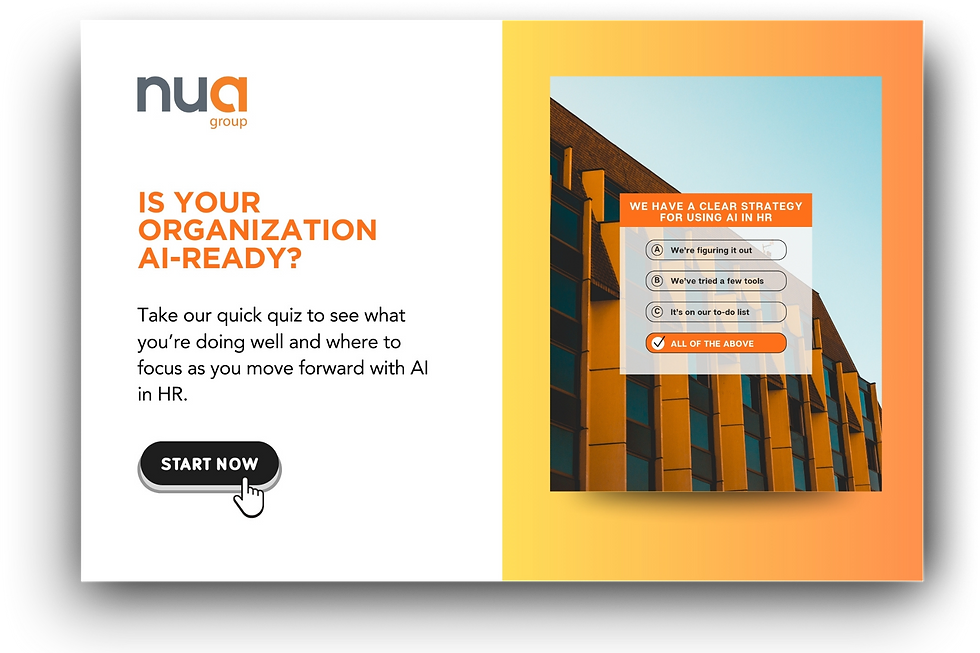The Smart Way to Plan Your 2026 HR Budget
- Elizabeth McFarlan Scott

- Sep 11
- 5 min read

Budget planning season can sneak up on even the most seasoned HR leaders. One minute you’re wrapping up performance reviews, finalizing compensation cycles, and gearing up for year-end talent planning. And the next, it’s time to submit your 2026 budget for sign-off.
While it might be tempting to simply roll over the budget from the previous year, that approach won’t cut it in 2026.
The pace of change isn’t slowing down. Economic volatility, shifting workforce expectations, and the rapid rise of AI mean HR leaders must plan budgets that go beyond “holding the line.” The choices you make now need to strengthen the foundations, deliver measurable results, and leave space for innovation.
Here’s how to approach it.
1. Get the Foundations Right
I’ve said it before, and it’s as relevant now as ever:
Beware of the shiny object.
The AI market is moving quickly, and not every solution is what it claims to be. Gartner predicts that 40% of AI projects will be cancelled, and many products are already suffering from “AI wash”, marketed as intelligent when they are little more than automation.
HR leaders are aware of the risks. In a recent workshop we hosted with CPOs, not a single leader was willing to sign an AI vendor contract longer than a year. They know the ground is shifting too fast. Core platforms like Workday and SAP SuccessFactors are steadily building out their own AI capabilities, which means that bolting on too many third-party tools today could leave you with costly redundancies tomorrow.
This is why budgets for 2026 must be anchored in strong foundations. Before you buy new technology, come back to two essential questions:
Do we have clean, accurate, and accessible data? AI and advanced HR tech are only as good as the data that fuels them. If your data is fragmented, inconsistent, or unreliable, even the most advanced system will fall short. Addressing this doesn’t just clean it up but creates governance, integration, and ongoing discipline. This is often where HR leaders lean on us to help them design processes and ownership models that make data integrity sustainable.
Are our processes designed for efficiency, not just tradition? Many HR processes are rooted in old systems or ways of working. Automating them “as is” only bakes in inefficiency. Redesigning workflows with today’s needs in mind, whether in recruiting, onboarding, performance, or pay, is what unlocks real value. It’s work we’re often brought in to do: helping HR leaders rethink and streamline processes so that technology investments actually deliver ROI.
Without solid data and efficient processes, no technology — AI or otherwise — will deliver what you expect. With them, you create the conditions for adoption, measurable impact, and long-term success.
2. Put AI in Context and Clarify HR’s Role
In 2024 and 2025, HR budgets started to include line items for AI tools. In 2026, the challenge shifts to operationalizing AI at scale.
That means budgeting for more than just the software. Integration across your HR ecosystem, maintenance of knowledge bases that fuel self-service, and governance to ensure compliance and ethical use all come with real costs. These investments are what make AI sustainable.
It also requires clarity about HR’s role in enterprise-wide AI projects. Increasingly, HR is pulled into initiatives alongside IT and senior leadership. But without clear alignment on goals, ownership, and budget responsibility, these efforts risk stalling. Before signing off, ask: What business problem are we solving? Who owns the initiative and the budget? And is there room to adjust if priorities change mid-year?
AI isn’t a set-and-forget investment. It requires training, monitoring, and constant improvement. That’s why many HR leaders look to us to help define their role in cross-functional AI programs, tie investments back to genuine business needs, and keep their budgets from being spread too thin.
3. Invest Both in People and Adoption
The best technology doesn’t fail because of code. It fails because people don’t use it, or because teams lack the capability to sustain it. Too many HR initiatives launch with great excitement only to fizzle when employees disengage or when HR lacks the skills to keep the system running.
That’s why adoption and capability need to be part of the budget from the start. This includes change management campaigns tailored to different employee groups, training and support for managers to reinforce new behaviors, and feedback loops to fix friction points before they turn into failures.
It also means investing in your HR team itself. As HR tech stacks expand, so does the need for skilled system administrators, data analysts, change managers, and process owners. Budget for upskilling your team, bringing in external expertise when needed, and creating career pathways that make these roles attractive to retain.
Protecting ROI means making sure the people side of transformation is fully resourced — from assessing capability gaps to designing adoption strategies. It’s work we regularly do with HR leaders who want to make sure their investments succeed beyond the go-live date.
4. Balance the Known and the New
Protecting the essentials, such as payroll accuracy, compliance, or workforce planning, will always come first. But if your budget is focused only on the “known,” you’re closing the door on opportunities to transform how HR delivers value.
Balancing means freeing up resources where you can. Simplifying policies and reducing duplicate processes across regions or business units not only saves money, it creates capacity to fund innovation.
The real question for 2026 is whether you’re willing to lead. Yes, the market is noisy, and some tools will overpromise. But ignoring what’s possible is just as risky as overinvesting in hype. The companies that move forward with targeted, well-governed bets are the ones that will unlock game-changing results.
5. Make ROI Everyone’s Business
In 2026, HR will be expected to show its math. The days of “trust us, it’s working” are over. Leaders want tangible evidence that HR’s budget choices are paying off.
That means defining measurable success criteria before initiatives launch, tracking progress quarterly, and being ready to reallocate if outcomes aren’t materializing. When ROI is visible, investments are easier to protect in lean times and easier to grow when opportunities emerge.
Making ROI visible requires the right governance and reporting structures. When those are in place, the budget conversation shifts away from cost and toward value. That’s where we often come in, helping HR teams put those structures in place so they can demonstrate impact with confidence.
Final Thought
Frankly, planning an HR budget for 2026 isn’t easy. The pace of change — from AI to shifting workforce expectations — makes it harder than ever to strike the right balance between stability and innovation. There’s no single formula. The right choices come down to clarity on priorities, the ability to adapt, and the discipline to follow through.
If you want a partner who will be right there with you, helping you not just plan your budget but put it into action in a way that delivers measurable results, let’s talk. We’d love to hear from you.
Whether you’re just starting to explore AI or already experimenting with tools, it’s helpful to know where your organization stands.
Before you go any further, answer a few quick questions to get a sense of your AI readiness. You will instantly receive your organization's AI-readiness score at the end of the quiz.





Comments